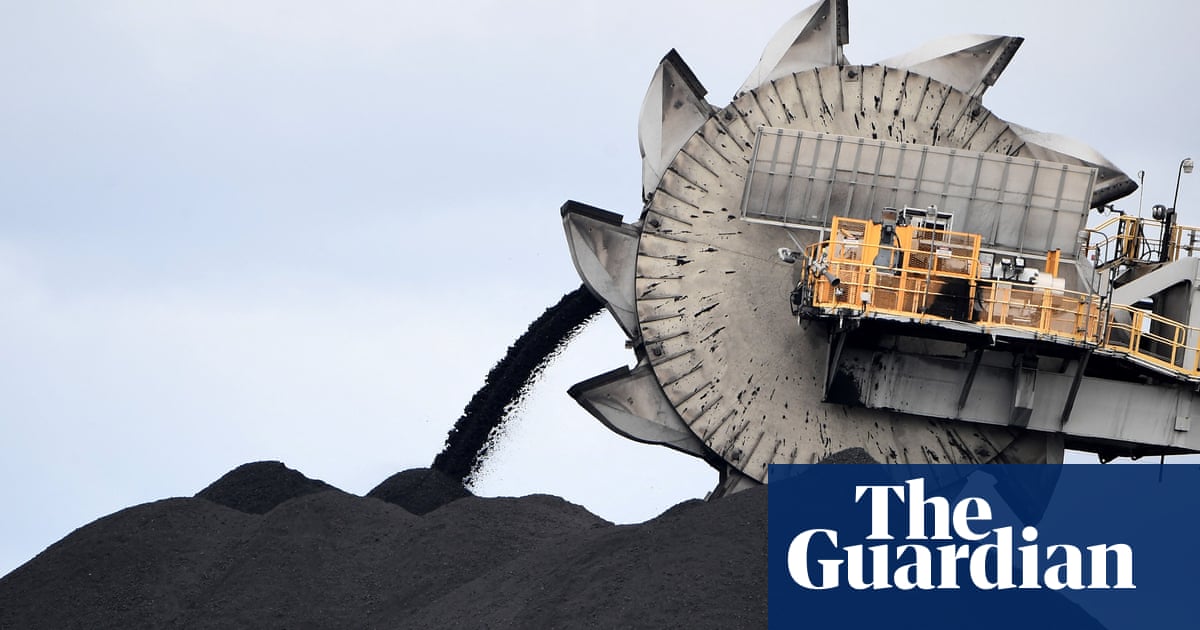Australia’s coal and gas exports cause more climate damage than those from any other country bar Russia, according to a new study that argues the country is undermining a global agreement to transition away from fossil fuels.
The analysis, commissioned by the University of New South Wales’ Australian Human Rights Institute, found Australia was the third biggest fossil fuel exporter on an energy basis in 2021, trailing only Russia and the US.
Australia ranked second on an emission basis. It overtook the US due to a majority of Australia’s exports being coal, a particularly emissions-intensive fuel.
It meant that while Australia releases about only 1% of global emissions at home, it was linked to about 4.5% once its exports were counted.
The report, by non-profit science and policy organisation Climate Analytics, said based on government forecasts, Australia’s fossil fuel exports were expected to remain at roughly the current level until at least 2035 as it continued to approve new coal and gas export developments.
Climate Analytics’ chief executive, Bill Hare, said this was incompatible with a range of international commitments Australia had made, including a call backed by nearly 200 countries at the Cop28 climate summit in Dubai in December for the world to transition away from fossil fuels, “accelerating action this decade”.
“Yet here we have the Australian government intent on a deliberate strategy that will see its gas exports soar, exporting billions of tonnes of emissions, inconsistent with achieving net zero, and completely inconsistent with the science of this issue,” he said.
Dr Gillian Moon, the project lead of the Australian Human Rights Institute’s climate accountability project, said it was striking that emissions from Australia’s fossil fuels exports had been about 30bn of CO2 over the 63 years since 1961 and this was forecast to increase by 50% between now and 2035.
She said the country was continuing on this path despite being more vulnerable to the effects of the climate crisis than most other countries. “We have domestic [emissions reduction] targets, but nothing on our exports. We export 91% of our coal and about three-quarters of gas, and we have no plan to get off this trade,” she said. “The Australian public deserve to know the truth about this and the consequences for us.”
Moon said if Australia was serious about its climate commitments, it should be doing more to encourage countries that bought its fossil fuels – particularly the developed economies Japan, South Korea and Taiwan that take about two-thirds of its exports – to move more rapidly to renewable energy. She said it should be having similar discussions with like-minded fossil fuel exporters, such as Canada and Norway.
She said it was striking that there was no discussion about fossil fuel production at global climate conferences held at the end of each year. “We have to have a conversation about how we’re going to deal with this,” she said.
after newsletter promotion
The analysis found if the global community were to live up to the headline goal of the landmark Paris climate agreement – that countries would try to limit global heating to 1.5C – emissions from fossil fuels would need to be reduced by 64% by 2035.
The report also said:
-
Australian fossil fuel exports in 2023 were likely to lead to 1.15bn tonnes of CO2 – nearly three times as much was emitted from within the country.
-
The country was responsible for 52% of global metallurgical coal exports and 17% of global thermal coal export in 2022. Metallurgical coal is used in steel-making, thermal coal in electricity generation.
-
Australia more than doubled its liquefied natural gas export capacity in the five years prior to 2020, adding 62m tonnes a year.
-
Only 19% of gas extracted in Australia is used within the country. The rest was either exported or used as energy by the export industry.
-
Australian governments and regulators had continued to grant permits for new large-scale gas production and LNG export projects in 2021 and 2022. This appeared at odds with a net zero roadmap released by the International Energy Agency, which found global gas use should decline 18-22% by 2030 and 47-53% by 2035 compared with 2022 levels.
The Australian resources minister, Madeleine King, last month announced the government would award nine permits to six companies – four to Esso and one each to Beach Energy, Woodside, Chevron, Inpex and Melbana – to explore for new gas reserves off the country’s west and south-eastern coasts.
Data published by the Guardian this week found the Australian proposals were part of a surge of new oil and gas exploration by wealthy democracies – including the US, UK and Canada – that threatened to unleash nearly 12bn tonnes of planet-heating emissions and undermine national and global climate commitments.
A recent report by the Institute for Energy Economics and Financial Analysis, a thinktank, challenged suggestions that Japan needed Australian gas to maintain its energy supply. It said demand for gas in the Asian country had fallen 25% over the past decade and the country was selling more LNG overseas than it bought from Australia.

